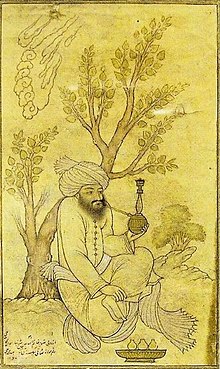Baha al-Din al-Amili | |
|---|---|
 18th century copy of a miniature depicting Sheikh Baha'i, falsely attributed to Sadiqi Beg. This drawing is presumably a copy of a lost original by Sadiqi Beg | |
| Born | 18 February 1547 |
| Died | 1 September 1621 (aged 74) |
| Title | Sheikh |
| Academic background | |
| Influences | Nimatullah Wali |
| Academic work | |
| Discipline | Shia Polymath, scholar, poet, philosopher, architect and mathematician |
| School or tradition | Isfahan School |
| Main interests | Mathematics, Architecture, Astronomy, Philosophy and Poetry |
| Notable works | Tashrīḥ Al-Aflāk, Al-Khashkūl, Nān wa ḥalwā |
| Influenced | Haydar Amuli, Mir Damad, Mulla Sadra, Mohsen Fayz Kashani |

Baha al-Din Muhammad ibn Husayn al-Amili (Arabic: بهاء الدين محمد بن حسين العاملي; 18 February 1547 – 1 September 1621),[1] also known as Bahāddīn ʿĀmilī, or just Sheikh Bahāʾi (Persian: شیخ بهایی) in Iran, was a Levantine Arab[2] Shia Islamic scholar,[3] poet, philosopher, architect, mathematician and astronomer, who lived in the late 16th and early 17th centuries in Safavid Iran.[4] He was born in Baalbek, Ottoman Syria (present-day Lebanon) but immigrated in his childhood to Safavid Iran with the rest of his family.[4] He was one of the earliest astronomers in the Islamic world to suggest the possibility of the Earth's movement prior to the spread of the Copernican theory.[1]
He wrote over 100 treatises and books in different topics,[1] in Arabic and Persian. A number of architectural and engineering designs are attributed to him, but none can be substantiated with sources.[1] These may have included the Naqsh-e Jahan Square and Charbagh Avenue in Isfahan.[5] He is buried in Imam Reza shrine in Mashad in Iran.
- ^ a b c d Hashemipour 2007.
- ^ Encyclopedia of Arabic Literature. Taylor & Francis; 1998. ISBN 978-0-415-18571-4. p. 85.
- ^ "Bahāʾ ad-dīn Muḥammad ibn Ḥusayn al-ʿĀmilī | Iranian scholar". Encyclopedia Britannica. Retrieved 2021-05-08.
- ^ a b Kohlberg 2009, pp. 429–430.
- ^ Kheirabadi Masoud (2000). Iranian Cities: Formation and Development. Syracuse University Press. pp. 47.